#fearsome critters
Explore tagged Tumblr posts
Text

A strange critter, galloping on all eight legs to great effect. Old Spider legs was only sighted the one time, running out of sight.
#BriefBestiary#bestiary#digital art#fantasy#folklore#legend#fearsome critters#old spider legs#beast#american legend
176 notes
·
View notes
Text

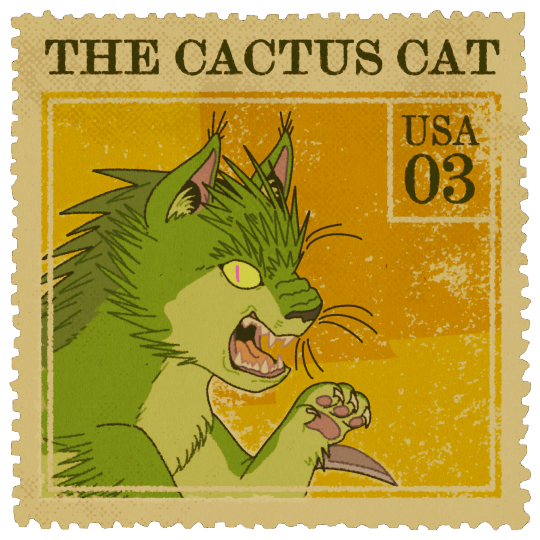
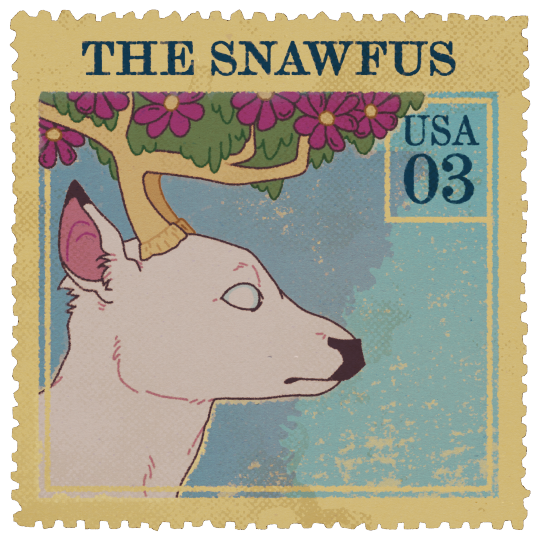

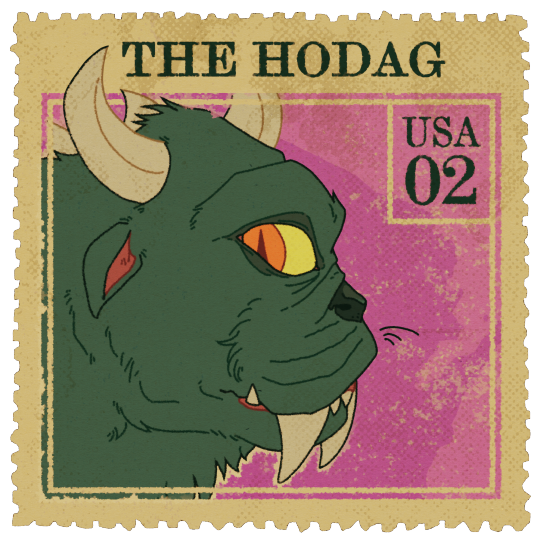




A set of stamps based on various North American cryptids
#illustration#stamps#cryptid#cryptids#cryptid art#fearsome critters#digital art#jackalope#cactus cat#snawfus#jersey devil#hodag#squonk#chupacabra#el chupacabra#snallygaster#fur bearing trout#my art#schoolwork
1K notes
·
View notes
Text

Cryptids & Creatures of Folklore Drawtober Day 25 — Silver Cat
During the early 1900s, American lumberjacks and other frontiersmen would tell tales of bizarre and terrifying creatures that supposedly lurked in the wild country around them. One of these creatures was the Silver Cat.
The Silver Cat was an enormous arboreal cat-like creature that was said to weigh over 300 pounds. It had tufted ears, red eyes with horizontal pupils, and a long tail that ended in a club with vicious spikes protruding from one side. Similar to a stegosaurus' thagomizer.
This creature lived in the tops of the tallest trees but would venture down to the lower branches when it grew hungry. There it would hang upside down and wait until something it deemed fit for dinner—usually a human—got close enough. The Silver Cat would then use the club on its tail to bash them in the head and then use the spikes to impale them and lift them up into the branches to be devoured.
#drawtober#cryptids#cryptozoology#fearsome critters#monsters#silver cat#illustrations#art#blood#gore#haha get thagomized
106 notes
·
View notes
Text
Belated Year of the Snake - Amphipteres and a Hoop Snake of Urvara




Happy Year of the Snake everyone! Hope everyone had a fun lunar holiday!
Just wanted to show some chimeric morphs of snakes in my Beast Fables setting, specifically the most common (amphipteres) an the rarer one that shows nature, even when influenced by magic, is silly sometimes.
Both serve the same purpose of giving snakes a means of travel, be it to look for new territory and prey OR to escape predators.
The King Cobra Amphiptere, one of the most feared of all amphipteres, thanks to an appetite of other snakes, enormous size, and ability to slay even experienced serpent-slayers. Were-snakes are especially fearful of it.
A Common Adder Amphiptere escapes the clutches of a Golden Eagle Griffon. Amphipteres in Erob are kind of seen as the "least" of the reptilian chimeras, by virtue of being smaller than other chimeras, and being mostly used to escape would-be predators.
A Titanoboa Amphiptere, the largest of all amphipteres and so huge it can't fly, swims through the water in search of large fish. A were-sea krait looks in awe.
A hoop snake tumbles down a slope, to a were-gila monster's surprise. A sign of good luck, so long as you don't stand in its way, as it turns into a whip when unfurled.
#beast fables#chimera#nazrigart#digital art#hoop snake#fearsome critters#cryptid#creature design#fantasy art#worldbuilding#fantasy worldbuilding#artists on tumblr#amphiptere
72 notes
·
View notes
Text
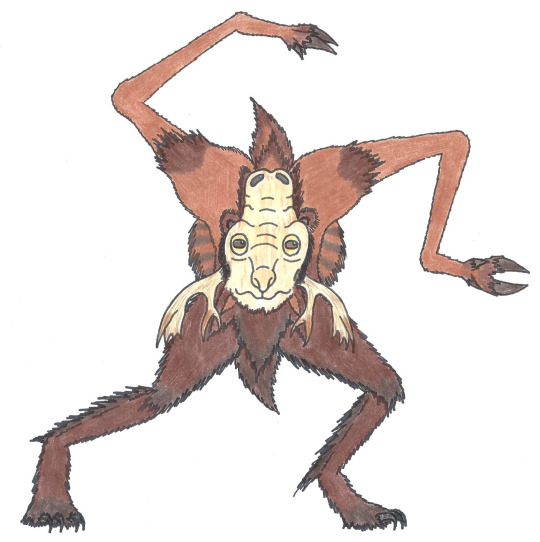
As the lumberjacks of old times could tell you, the forest is full of mysteries and dangers. In some cases, though, there can also be mischief. Sometimes, the creatures in these woods aren't here to cause bodily harm, instead finding amusement in causing confusion and the occasional fisticuffs.
While most folk call this species "Toteroad Shagamaw," its original name was simply "Shagamaw." That is what the natives in this region used to refer to this odd creature, with the "toteroad" part only coming in when lumberjacks began to encounter it. To the first people of this land, the Shagamaw was a tracker's entry test, to see if one was skilled enough to follow the ever-changing footprints. At first they would look like bear tracks, but then later moose, when in truth it was neither of these beasts. Shagamaw were rarely hunted, but were kept away from settlements due to their taste for cloth. Due to their shifting bodies, changing tracks and thieving ways, they were seen as an embodiment of a trickster god. When settlers came to these lands, and the lumber industry began, these strangers were quick to learn why the Shagamaw earned such a reputation.
The arrival of outsiders to their woods must have been a joyous time for the Shagamaw, as they now had a new crop of ignorant folk to torment. The natives here had long figured out the Shagamaw's tricks and deceptions, even knowing that they walked 440 steps on one set of limbs before rotating. But this fresh batch was unaware, and had the tendency to ignore the locals. And as their industry moved in, so did a new supply of cloth and cotton for them to eat.
Thus the Shagamaws began to pop up around logging camps and travel the tote roads. They would swipe whatever clothing had been left out, and use trickery to make workers leave behind tasty pieces. Their tracks leaving camp would garner attention, and thus the lumberjacks would pursue. However, their efforts would inevitably fail, as the tracks shifted into different shapes. While this was meant to confuse their pursuers, it also caused quite a few fights when inebriated loggers would accuse one another of misidentifying tracks and following the wrong beast. Shagamaws would purposefully choose tracks that would best garner a response: be it a moose for eager hunters, or a bear's when looking to scare folk away. All of this was done to lure lumberjacks away from camp or their washings, and then the Shagamaw would swoop in for dinner.
While they had good times at the loggers' expense, they would not last forever, as even these folk would grow wise to these antics. Eventually they would identify the Shagamaw and learn how to spot their tracks. Lumberjacks refused to get baited by them, and they would instead start using traps to catch these buggers. While the meat on these creatures was a bit lacking, folk found amusement out of their strange pelts. To have the fur of both a moose and bear all in one! Trappers and hunters would catch them for these furs, selling them as wonderful oddities and quaint trophies. Even as the years went on, the strangeness of a Shagamaw's pelt still delighted folk, and their hunting continued. Thankfully, these creatures are smarter than most other woodland critters and knew when to make themselves scarce. They would eventually retreat deeper into the wilds to avoid hunting, and their populations spent quite a few years in hiding. However, the pressure would soon relent, and the Shagamaw's would start spreading back out again. Times had changed, which helped in some regard but infuriated in others. What were the Shagamaws to do when they found that humans no longer cared about simple tracks?
In modern times, the Shagamaw is an odd relic that earns an amused snort and that's about it. Man was no longer deceived by their baffling tracks, but mostly because they didn't track any more. A person walking the woods would only point at such markings and then move on, never taking the bait. Such deceptions were lost on the common folk, and thus the gimmick of the Shagamaw was ineffective. While the species is still appreciated in some regards, like two-in-one stuffed animals and hunting club mascots, the Shagamaw wound up slipping into unconcerned obscurity. Maybe you may hear the old tidbit about how there used to be the "Shagamaw" unit of distance. Be it "two legs of a Shagamaw" (that is 440 steps), or "one leg" (220 steps) or "four legs" (880 steps). But the most they do now is torment the occasional rookie camper, scaring them with bear tracks near their tent and making off with left out hiking socks.
--------------------------------
"Toteroad Shagamaw"
Okay, may have gone a liiiiittle nutty with the design on this one, but I really didn't want to draw a regular ol satyr for this. Oh hi, Buer!
90 notes
·
View notes
Text

working on some silly little friends
94 notes
·
View notes
Text
I keep forgetting to post this so uh...
Tripodero, Sakura pen and white brush pen on sketchpad paper, 2024

Kinda like how this guy looks... might do a black shuck, chickcharney or something else next...
130 notes
·
View notes
Text
Creatures, and animals that the critters you can get in Critter Rehabitation Center are based on.
Tripodero



The tripodero is one of the fearsome critters. The fearsome critters are made up animals, that American wood cuters made up as jokes.
The hunts, by shooting clay at it's pry with it's nose. The clay pellets stun the pry, allowing the tripodero to devour it. The tripodero is associated primarily with construction sites, railroads, and engineering projects.
2. Splintercat




The splintercat one of the fearsome critters too.
It's a really strong cat, that flays through the air, and breaks trees with it's head, by runing into them.
3. Teakattler


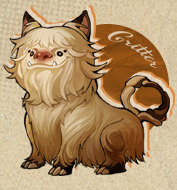
The teakettler is an another fearsome critter. It's a small animal, that sounds like whistle of a teakettle. Walks backwards, and has steam comming out of it's nose.
4. Dodough


The dodough, is not based on a mythical animal, but an extinc one. It's based on the dodo bird.
The dodo was a flighless bird, that lived on Mauritius. It's on the coat of arms of the country. Those birds were isolated for a long time, and because of this, these birds were fearless. This lead to they extinction. The dodo went extinct because of deforestation, hunting, and they nests being distroyd by animals like rats and dogs that the Duch brought with them to the island.
They went extinct in 1681.
5. Moon-Eyed Fiddler

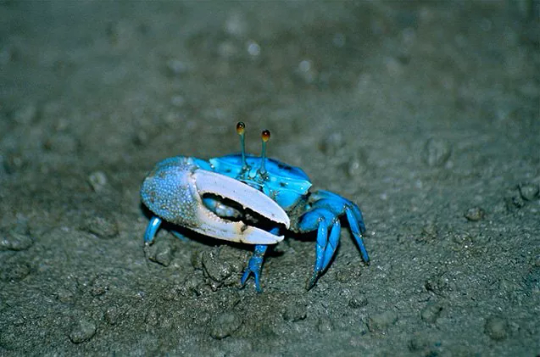

It's based on the fiddler crab. (Sorry for the bad picture).
6. Sarmatian deal snail



The sarmatian deal snail is a big snail. It has antler with gleaming, pearl-like tips, a rounded cat-like snout with whiskers, glowing eyes that light it's path in the dark, a thick neck, a long tail, and unlike ever other snail it has lefs with claws.
It usually is in the open sea, but when the weather is good it sometimes goas out to the beach to sun gaze.
Most of the reports of this snail are from Denmark.
7. Pinnacle grouse


An another one of the fearsome critters.
The pinnacle grouse is a bird that only has one wing, that is strong enough to fly. When it's flaying, it's suprisingly elegant, and fast.
8. Furry anglerfish


The furry anglerfish is ovoiusly based on the anglerfish.
9. Axehandle hound

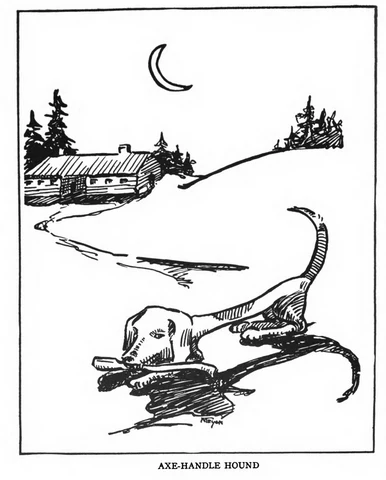

And last but not least, the axe-handle hound. An another one of the fearsome critters.
It's a dog with a body that resemembles a axe handle, head is shaped like an axe blade, and with short stubby legs.
These dogs's diet consists of axe handles.
Sources:-Wikipedia
-A Book od Creatures
-SamKalensky
#reverse 1999#Critters#Reverse 1999 critters#fearsome critters#Tripodero#Splintercat#Teakattler#Dodo#dodo bird#fiddler crab#Sarmatian deal snail#Pinnacle grouse#anglerfish#Axehandle hound#I enjoy the Critter Rehabitation Center of this game#Exept for how I had to rework my wilderness and how the road ruind it#The only time that road will be there is when something is made there#Other waise it will not
25 notes
·
View notes
Text
There’s an old lumberjack legend that leprechauns were brought as pets to a logging camp on the Madawaska River, they escaped into the muskeg and now Canada is just full of feral man-eating leprechauns.
And I think about that a lot.
210 notes
·
View notes
Text

Inktober Day 19: Ridge
-----
om-nom-nom
This Fearsome Critter is the Slide-Rock Bolter. Lumberjacks in the Colorado mountains told stories of creatures that would hang off the side of a mountain by their tail until something walked into their path. Then they would let go and slide down the ridge to eat 'em up Pac Man style.

#i just think they're neat#inktober#inktober2024#ridge#day 19#traditional art#fearsome critters#cryptids#my art#arlo does inktober#slide rock bolter
22 notes
·
View notes
Text

Some hodags eating Wisconsin foods
25 notes
·
View notes
Text

A creature skilled in pranking hunters. One sole taxidermied specimen was displayed alongside a handful of other critters at the Buckhorn Tavern near Rice Lake, Wisconsin.
#BriefBestiary#bestiary#digital art#fantasy#folklore#fearsome critters#dingbat#bunkeri edithil#north american folklore#north american legend#beast
32 notes
·
View notes
Text

Inktober day 30
12 notes
·
View notes
Text

Cryptids & Creatures of Folklore Drawtober Day 4 — Slide Rock Bolter
The Slide Rock Bolter is a "fearsome critter" from North American folklore. Tales of this terrifying beast began in the 1800s and came from lumberjacks who claimed the monstrous beast lurked in the Colorado mountains.
They described it as being a gigantic, whale-like creature with a massive toothy mouth, tiny eyes, a tale fluke like a dolphin, and two hook-like claws on the end of the tail. It was said to lurk near the top of mountains—but only those with slopes at a 45 degree angle or greater—where it would wait until prey came into range. Then the creature would release its claws and slide down the mountain to attack. It would drool a grease-like substance from its mouth during its descent to help it pick up speed, then would gulp up its prey, and finally use the built up momentum to propel itself on up onto the next mountain to ready itself for its next meal.
This Slide Rock Bolter has lucked out though and found himself a home next to a popular mountain trail pass. He doesn't even have to leave his perch to get a snack and he has been in the same spot for so long that trees have started growing on his back.
#drawtober#cryptids#cryptozoology#fearsome critters#slide rock bolter#folklore#monsters#illustrations#art
126 notes
·
View notes
Text



#Polls#Voting#Concepts#Doll making#Fearsome Critters#Fish Fox#Hodag#Snow Wasset#Let's see which lucky two dolls will be made this Spring!#May make this a tradition for each year#Art#My art#Traditional Art#Analog Media#Watercolors#Acrylic paint#Brown ink
7 notes
·
View notes
Text

During Canadian winters, it is advised to stay indoors and avoid spending too long outside, especially in the more remote regions. Certainly the snow and cold are dangerous things, and folks want to avoid hypothermia or getting lost in the chaotic frigid weather. However, there is another danger they warn about out there, one that arrives with the winter season and can be just as invisible as the insidious chill. When the ground and trees are blanketed in white snow, and the wind dies down, it can seem tranquil out there in the wintry wilds. The scene may look peaceful, with not a single soul around, but there is a chance you are actually not alone out there. A creature stirs while others may sleep, and those who tread upon the snow know well enough to do so lightly. Winter brings the snow and cold, but it also brings the Snow Wassets.
Northern folk know Snow Wassets quite well, sometimes referring to them as "Arctic Weasels." They do appear to be a mustelid, though their length and size can put other members of that family to shame. The species is known as a stealthy and deadly hunter, but only during the winter season. They burrow their long serpentine bodies beneath the snow, and slither below undetected. With sensitive ears and whiskers, they sense the sound of prey blundering across the snowy layer, and strike with unnatural speed. The hunt of a Snow Wasset is over in seconds, as they explode out of the snow and sink their long teeth into their meal. They typically aim for the throat, crushing the wind pipe and then dragging them down. When a kill is scored, they pull their prize into the snow, then use their long bodies to brush more snow over top of it, so they may dine in peace. With a layer of white disguising the hunter and the hunted, there is less of a chance of scavengers stealing from them.
Snow Wassets are incredible hunters and masters of ambush, and they are capable of taking a variety of prey down. It can eat simple rabbits and grouse, but can also feed upon the likes of wolves, deer and even man. When winter is in full swing and food is scarce, they are not likely to pass up any tempting morsel they come across. And for this reason, Snow Wassets are feared out in the wintry wilds by both man and beast. There have been a number of stories where witnesses saw a wolf pack's hunt being interrupted by an emerging Snow Wasset, taking advantage of their distraction to grab one of the canines. This same tactic is why hunters are warned about chasing blindly after prey, lest they stumble right into the jaws of a wasset.
Though the Snow Wasset is seen as a vicious winter beast, it is not always a ravenous monster. When spring time comes around, and the snow begins to melt, their hunting method ceases to work and they flee north. As the weather grows warm, their white coat grows green, to better hide themselves in the new foliage. Not only do they change color, but they grow simple limbs to help them crawl across the ground and slink through the shadows. They continue to ambush food from the underbrush, but their prey is much smaller and the wasset is far less bold than it would be in winter. Eventually, when the summer heat cranks up, the Snow Wasset will find a marsh and dig itself a burrow. There it will hibernate through the peak summer season, only waking when cooler temperatures arrive. It is when the first snow comes when the wasset will change its coat back to white and shed its crude limbs. These appendages fall off much like how a lizard may drop its tail. The Snow Wasset will head south, and soon the winter hunt will be on.
Due to their aggression and wide variety of prey, the Snow Wasset is seen as a danger and a maneater. They are often blamed for any disappearances that occur during the winter whenever the missing person had gone out to the remote woods. In the early days, the Snow Wasset's hunts were attributed to ghosts and frigid spirits, vanishing those who dared tread into the cold dark forest. In time, though, the natives of the land learned of the Snow Wasset's existence and crafted new tales and purpose for this beast. They would develop ways to confuse the predator and avoid a terrible fate, with the main method being a special way of walking across snow. The Snow Wasset relies on vibrations and sound to detect prey, and is smart enough to memorize the patterns of food. However, the natives found that moving with irregular rhythm and breaking up their sequence of steps would prevent the wassets from catching on to their presence. The resulting movement comes out very dance-like, and has been incorporated into a few of the tribe's celebrations.
While the natives were able to avoid being eaten by the Snow Wasset, their efforts didn't stop there. They figured out a way to hunt them, with the use of bait and logs. The method calls for setting up dead falls around an area, with each log aimed to roll inward once the signal is given. In the center of this ring would be live bait, whose movements would attract the wasset. When the creature attacked, the signal would be given and the logs would be released, rolling inward atop the beast. Because the Snow Wasset's long body is obscured by the snow, there is no telling where to set the trap. Thus the use of many logs to cover the area so that one may succeed in pinning its hidden body. Once the massive weasel is trapped, the hunters rush in to finish it off. Snow Wassets were rarely hunted for food, and more so for their valuable pelts. In their wintry form, they lack limbs and thus their furs come with no holes. And since their hide is designed to keep out the cold and wetness of snow, the natives found it made for excellent winter wear, sleeping bags, as well as canoes! By stretching the head across a wooden frame, a one man canoe could be easily crafted. The technique of building one, as well as hunting a wasset, is taught to every member of the tribe as a lesson in survival.
Eventually, loggers and trappers would make their way to these cold remote forests, and have their first encounters with the Snow Wasset. The natives made an attempt to warn these newcomers of the hidden beast, but their words were often brushed aside as "superstition" and "ghost stories." When folk started vanishing, then the lumberjacks started believing these tales. They attempted to learn the walking technique as a way to avoid attacks, but would screw it up most the time. Instead, their way of escaping a hungry wasset was to put spurs on their boots, which would let them scramble up trees when a wasset was around. Up there, they would simply wait til the creature got bored and left, which only worked for so long. Snow Wassets are clever beasts and can memorize sounds and patterns, and a falling tree was a noise they started getting used to. A toppling tree usually meant animals fleeing amidst the din, which meant easy pickings. And now they would learn that this noise also meant other morsels were nearby, ones that were responsible for starting all the ruckus. In time, the Snow Wassets would lurk around winter logging operations for better hunting opportunities, which also meant eating a couple lumberjacks as well. Since warding them off was a problem, and spotting them in the first place was near impossible, logging companies soon took to using poisoned bait to kill local wassets. The result was a drop in nearby populations, until only those in the remote wilderness remained.
In more recent years, with the scaling back on mass logging of these areas, the Snow Wassets have slowly returned to some of their natural ranges. However, the fear and reputation of them still lingers. The same warnings given decades ago hold true to remote towns and villages, where one should be wary about wandering through the snow. Cross country skiers and snow shoe enthusiasts are common victims, especially when many winter time tourists ignore the warnings. Some parks and alpine areas have created "Snow Wasset proof" trails and barriers to keep travelers safe, but those only protect the people who stay on them. No matter how many signs and fences you put up, someone is going to get the bright idea of pretending they don't exist. Snow Wassets have also become a popular target amongst hunters and trappers, who see them as an impressive trophy. While deer are turned into mounts and bears into rugs, hunted Snow Wassets tend to be crafted into things like fur curtains, scarves and even body pillows. While their meat isn't seen as anything special, wasset legs are viewed as a delicacy. When the time comes for the beasts to shed their limbs, folk scour the countryside to collect them. They are said to make an incredible stew or chili, while some people prefer to eat them off the bone.
Though they are feared, Snow Wassets do show up in various parts of culture. They make excellent mascots for winter sports teams, especially for bobsledding and hockey. Their green spring time versions show up at cranberry farms, as the wassets tend to hibernate in such bogs. Stuffed animals of them are also made as either toys or charming scarves. They are used as a sign of the changing seasons, be it their color shifting fur or shedding limbs. The saying "still got some green on its fur" is used when winter is not quite here yet, while "wasset finally got its shoes" is for when spring at last arrives. And of course who could forget Snow Wasset Day? The time honored tradition when folk gather around a Snow Wasset burrow and watch it emerge. If the wasset comes out and sees its shadow, it will retreat back inside and cause summer to go on for six more weeks. If they emerge without issue, then fall and winter are soon to come. Towns in the Labrador province have made a whole ceremony out of this superstition, to the point where everyone now knows Wabush Will, the famous Snow Wasset that decides how long summer lasts. Every year, people watch the event either in person or on live stream, to see the famed wasset do his thing. The tradition has gone on for decades, requiring for there to be multiple Wabush Wills. In time, each one retires and a new Wabush Will is given the official burrow for them to hibernate in and emerge from. However, it should be noted that "retired" and "too old to do the job" is the language they use to make things sound all nice and happy. One has to remember that once the wasset has left their burrow, they vanish into the wilds and go hunting. No one can control what ol Wabush Will does at that point, or who he eats. Quite a few Wabush Wills were "retired" when they were snagged by a trapper or shot in the head when they had their teeth in the throat of a skier.
While the Snow Wasset population has grown from its previous slump, many fear that their numbers may be in trouble once more. As climate change continues, the weather gets warmer and the winters more mild. Snow is not as plentiful as it once was, which means harder hunting conditions for the wassets. Spring seems to come much faster, and hotter summers call for longer hibernation. Since they have to sleep for longer, they need more food to gorge on. And with less snow in their typical ranges, they need to either move elsewhere or become more bold in their hunting. As a result, Snow Wasset attacks are slowly starting to rise, as they become desperate for food. There have even been encounters during spring, when the Snow Wasset should be more timid. But their need for food means they need to be more aggressive, and not pass up on any meals. If things don't change soon, the wasset warnings won't only apply to winter anymore....
-------------------------------------------------
"Snow Wasset"
Fearsome Critter time! I chose this one because I thought the entry would be shorter to write but oops!
72 notes
·
View notes